Research on Time-Sensitive Service Transmission Routing and Scheduling Strategies Based on Optical Interconnect Low Earth Orbit Mega-Constellations
Abstract
:1. Introduction
- (1)
- Establish a routing and scheduling model named parallel subnetworks—FJSP—Reinforcement Learning Scheduling, abbreviated as “PSFRS”, for time-sensitive business transmission in the scenario of optical interconnect parallel subnetworks. The objective is to minimize the multi-hop transmission delay for time-sensitive businesses, reduce resource consumption for satellite transmission, and adhere to constraints, such as the maximum number of simultaneous transmissions per satellite, the maximum number of hops for packet transmission, packet transmission interruption constraints, and the absence of priority constraints for time-sensitive business. Considering the characteristics of packet transmission in the objective function and constraints, we formulate the routing and scheduling strategy problem to achieve controllable multi-hop transmission delay in Low Earth Orbit satellite constellations. This problem involves multiple objective functions and coupled variables, making it challenging to obtain analytical solutions.
- (2)
- Address the potential queuing issues that may arise between subnetworks after reconfiguration in the optical interconnect parallel subnetwork. We utilize the controllability of delay in a single satellite using CQF gate scheduling in time-sensitive business transmission technology to extend the local end-to-end delay optimization problem to a global routing delay optimization problem. Consequently, the routing and scheduling problem in Low Earth Orbit satellite constellations transforms into a classic Flexible Job Scheduling Problem (FJSP). This transformation significantly enhances the feasibility of utilizing optical interconnect parallel subnetworks for time-sensitive business transmission and introduces a new approach for employing CQF gate scheduling for transmission in Low Earth Orbit satellite constellations.
- (3)
- Given the characteristic of optional selection for each hop in the routing of time-sensitive business transmission, we employ Q-learning-based reinforcement learning to solve the problems. This solution aligns with the requirements of routing and scheduling for time-sensitive business transmission in Low Earth Orbit constellations. Compared to traditional algorithms, this approach offers a superior solution to the NP-hard problem.
- (4)
- Building upon the previous work of the Optical Communication team at Shanghai University, simulations were conducted using existing simulation platforms and the specialized TSN simulation tool OMNET++ to validate the proposed models and routing scheduling strategies in time-sensitive business transmissions. The experiments focused on testing key metrics, such as algorithm complexity, constellation task burden, and end-to-end latency.
2. Related Work and Problem Description
2.1. Low Earth Orbit Giant Constellation
2.2. Low Earth Orbit Satellite Routing and Optical Laser Interconnection
2.3. Parallel Subnetwork Routing Architecture
2.4. Time-Sensitive Network and Deterministic Network
2.5. Reinforcement Learning Algorithm
- (1)
- Reward: The goal of reinforcement learning is to maximize rewards. The agent receives a reward after each interaction with the environment;
- (2)
- Policy: A policy refers to the action plan devised based on the current situation. In reinforcement learning, a policy indicates the probabilities that guide the agent in choosing actions in different environments;
- (3)
- Agent: In reinforcement learning, the agent plays the roles of observer, decision maker, and learner. Depending on the number of agents involved, reinforcement learning can be categorized into multi-agent and single-agent models;
- (4)
- Environment: The environment encompasses all aspects of reinforcement learning apart from the agent, including the current location and transition rules. It refers to the uncontrollable elements in the learning process.
- (1)
- The agent observes the current environment and obtains its own state S.
- (2)
- The agent makes decisions based on its current observations and its policy, selecting an action A to execute.
- (3)
- The agent changes its state based on the executed action through the environment and receives a reward R.
3. Materials and Methods
3.1. The Structure of the Proposed Model
- (1)
- The introduction of the optical interconnect parallel subnet aims to overcome the limitations of traditional Low Earth Orbit constellation routing for the transmission of time-sensitive services. The latter faces some obstacles that are difficult to overcome at the transmission level. Detailed explanations of the optical interconnect parallel subnet can be found in Section 3.2.
- (2)
- The introduction of the CQF (Credit-based Queueing and Forwarding) gate control scheduling in TSN (Time-Sensitive Networking) technology aims to enhance the stability and controllability of time-sensitive service forwarding and processing in LEO (Low Earth Orbit) satellite networks. Detailed explanations of the CQF gate control schedule can be found in Section 3.3.
- (3)
- The mathematical modeling of routing in LEO satellite networks based on CQF scheduling is conducted because the various factors and constraints of this issue align with classical industrial processing control problems, making it amenable to transformation. Details of the mathematical modeling are discussed in Section 3.4.
- (4)
- The introduction of reinforcement learning for solving the satellite routing scheduling problem is aimed at leveraging scenarios that align with the application conditions of reinforcement learning, thereby reducing the likelihood of traditional solutions getting stuck in local optima. Detailed information on the utilization of reinforcement learning is provided in Section 3.5.
- (5)
- The performance of the time-sensitive service transmission model based on the optical interconnect parallel subnet is compared with traditional routing scheduling algorithms and conventional solving methods to demonstrate its advantages. Specific experimental results are presented in Section 4.
3.2. Detailed Description of the Routing Algorithm
3.3. CQF Scheduling Mechanism
3.4. Mathematical Problem Modeling
3.5. Solution Based on Reinforcement Learning
- (1)
- State Space. The state space can be defined as a finite set of all jumps. To facilitate the representation of all states, coupling numbers can be used, where represents the packet number and represents the jump number.
- (2)
- Action Space. The agent selects a satellite for forwarding based on the current state, which includes each hop during forwarding and the satellite situation. In this problem, the total number of satellites is , so the action space is typically defined as a finite set of the number of satellites, denoted as .
- (3)
- Reward Function. The optimization goal is to minimize the maximum transmission time and minimize the total task burden. The larger the satellite task burden, the smaller the reward ; the longer the total transmission time of the satellite, the smaller the reward .
- (4)
- Selection Policy. When the agent is in a certain state S, taking an action will, with a probability of 1 − , choose the action corresponding to the maximum Q-value in the Q-list, and, with a probability of , randomly select an action.
- (5)
- Random Generation of Jump Codes. Randomly generate process codes. Under the constraints of the problem, feasible jump codes are randomly generated based on the number of packets and transmission hops as prior knowledge for the algorithm.
4. Experiment
4.1. Simulation Model Establishment
4.2. Experimental Results
5. Conclusions
Author Contributions
Funding
Institutional Review Board Statement
Informed Consent Statement
Data Availability Statement
Conflicts of Interest
References
- ITU. Internet. Access Statistics [EB/OL]. 2022. Available online: https://www.itu.int/en/ITU-D/Statistics/Pages/stat/default.aspx (accessed on 1 March 2023).
- Chen, Q.; Yang, L.; Guo, J.; Li, X. LEO mega-constellation network: Networking technologies and state of the art. J. Commun. 2022, 43, 177–189. [Google Scholar]
- Blondel, V.D.; Guillaume, J.L.; Lambiotte, R.; Lefebvre, E. Fast unfolding of communities in large networks. J. Stat. Mech. 2008, 2008, P10008. [Google Scholar] [CrossRef]
- Hong, Y.; Zhang, J.; Zang, J.; Fan, X.; Zhao, Q. Parallel Subnetwork Routing Algorithm for Inter-Satellite Optical Communication. In Proceedings of the 2023 Asia Communications and Photonics Conference/2023 International Photonics and Optoelectronics Meetings (ACP/POEM), Wuhan, China, 4–7 November 2023; pp. 1–3. [Google Scholar]
- Jing, Y.; Yi, L.; Zhao, Y.; Wang, H.; Wang, W.; Zhang, J. Deep-learning-based path computation without routing convergence in optical satellite networks. J. Opt. Commun. Netw. 2023, 15, 294–303. [Google Scholar] [CrossRef]
- Ruan, Y.J.; Hu, M.; Yun, C.M. Advances and prospects of the configuration design and control research of the LEO mega-constellations. Chin. Space Sci. Technol. 2022, 42, 1–15. [Google Scholar]
- IEEE 802.1; IEEE Standard for Local and Metropolitan Area Network–Bridges and Bridged Networks. IEEE Std 802.1Q-2018 (Revision of IEEE Std 802.1Q-2014). IEEE: New York, NY, USA, 2018; pp. 1–1993.
- Yan, J.; Quan, W.; Jiang, X.; Sun, Z. Injection Time Planning: Making CQF Practical in Time-Sensitive Networking. In Proceedings of the IEEE INFOCOM 2020—IEEE Conference on Computer Communications, Toronto, ON, Canada, 6–9 July 2020; pp. 616–625. [Google Scholar]
- Hellmanns, D.; Falk, J.; Glavackij, A.; Hummen, R.; Kehrer, S.; Dürr, F. On the performance of stream-based, class-based time-aware shaping and frame preemption in TSN. In Proceedings of the 2020 IEEE International Conference on Industrial Technology (ICIT), Buenos Aires, Argentina, 26–28 February 2020; IEEE Press: Piscataway, NJ, USA, 2020; pp. 298–303. [Google Scholar]
- Reusch, N.; Zhao, L.; Craciunas, S.S.; Pop, P. Window-based schedule synthesis for industrial IEEE 802.1Qbv TSN networks. In Proceedings of the 2020 16th IEEE International Conference on Factory, Porto, Portugal, 27–29 April 2020. [Google Scholar]
- Hasan, M.M.; Feng, H.; Khan, S.; Ullah, M.I.; Hasan, M.T.; Gain, B. Improve service curve using non-overlapped gate in time sensitive network switch. In Proceedings of the 2021 IEEE 21st International Conference on Communication Technology (ICCT), Tianjin, China, 13–16 October 2021; IEEE Press: Piscataway, NJ, USA, 2021; pp. 913–918. [Google Scholar]
- Zhao, L.; Pop, P.; Gong, Z.; Fang, B. Improving latency analysis for flexible window-based GCL scheduling in TSN networks by integration of consecutive nodes offsets. IEEE Internet Things J. 2021, 8, 5574–5584. [Google Scholar] [CrossRef]
- Wu, Z.; Hu, G.; Jin, F.; Song, Y.; Fu, Y.; Ni, G. A novel routing design in the IP-based GEO/LEO hybrid satellite networks. Int. J. Satell. Commun. Netw. 2017, 35, 179–199. [Google Scholar] [CrossRef]
- Huang, Y.; Feng, B.; Dong, P.; Tian, A.; Yu, S. A multi-objective based inter-layer link allocation scheme for MEO/LEO satellite networks. In Proceedings of the 2022 IEEE Wireless Communications and Networking Conference (WCNC), Austin, TX, USA, 10–13 April 2022; pp. 1301–1306. [Google Scholar]
- Truchly, P.; Vangel, M. Performance of multilayered satellite networks. In Proceedings of the ELMAR-2012, Zadar, Croatia, 12–14 September 2012; pp. 113–116. [Google Scholar]
- Jing, Y.; Yang, Z.; Liao, X.; Qi, X. A minimum connected dominating set based multicast routing algorithm in hybrid LEO/MEO/GEO constellation network. In Proceedings of the 2017 International Conference on Communications, Signal Processing, and Systems, Noida, India, 7–9 March 2019; Springer: Singapore, 2019; pp. 93–100. [Google Scholar]
- Cui, X.; Wu, J.; Zhou, Y.; Liu, L.; Pan, Z. Challenges of and Key Technologies for the Air-Space-Ground Integrated Network. J. Xidian Univ. 2023, 50, 1–11. [Google Scholar]
- Yang, F.; Zhao, J.; Yao, N.; Li, Z.; Jiang, H.; Wang, J.; Zhu, H.; Liu, S.; Wang, S.; Wang, X. System design and technical innovation of BJ-3A/B Satellites. Spacecr. Eng. 2023, 32, 7–15. (In Chinese) [Google Scholar]
- Zhang, X.; Yang, Y.; Xu, M.; Luo, J. ASER: Scalable Distributed Routing Protocol for LEO Satellite Networks. In Proceedings of the IEEE Conference on Local Computer Networks (LCN), Edmonton, AB, Canada, 4–7 October 2021; IEEE Press: Piscataway, NJ, USA, 2021; pp. 65–72. [Google Scholar]
- Zhu, Y.; Qian, L.; Ding, L.; Yang, F.; Zhi, C.; Song, T. Software defined routing algorithm in LEO satellite networks. In Proceedings of the 2017 International Conference on Electrical Engineering and Informatics (ICELTICs), Banda Aceh, Aceh, Indonesia, 18 October 2017. [Google Scholar]
- Zhu, Y.; Rui, L.; Qiu, X.; Huang, H. Double-Layer Satellite Communication Network Routing Algorithm Based on Priority and Failure Probability. In Proceedings of the International Wireless Communications and Mobile Computing Conference (IWCMC), Tangier, Morocco, 24–28 June 2019; pp. 1518–1523. [Google Scholar]
- Osoro, O.B.; Oughton, E.J. A techno-economic framework for satellite networks applied to low earth orbit constellations: Assessing Starlink, OneWeb and Kuiper. IEEE Access 2021, 9, 141611–141625. [Google Scholar]
- SpaceX. Starlink—starlink.com. March 2023. Available online: https://www.starlink.com/ (accessed on 31 March 2023).
- Nasrallah, A.; Thyagaturu, A.S.; Alharbi, Z.; Wang, C.; Shao, X.; Reisslein, M.; ElBakoury, H. Ultra-Low Latency (ULL) networks: The IEEE TSN and IETF DetNet standards and related 5G ULL research. IEEE Commun. Surv. Tutor. 2019, 21, 88–145. [Google Scholar]
- Liu, H.; Li, M.; Gu, F.; Li, Q.; Zhang, W.; Guo, S. End-to-end Flow Scheduling Optimization for Industrial 5G and TSN Integrated Networks. In Proceedings of the GLOBECOM 2024—2024 IEEE Global Communications Conference, Cape Town, South Africa, 8–12 December 2024; pp. 1797–1802. [Google Scholar] [CrossRef]
- Malis, A.; Geng, X.; Chen, M.; Varga, B.; Bernardos, C. Deterministic Networking (DetNet) Controller Plane Framework. Internet Engineering Task Force. 2023. Available online: https://datatracker.ietf.org/doc/draft-ietf-detnet-controller-plane-framework/ (accessed on 30 December 2024).
- Liu, F.; Zeng, G. Study of genetic algorithm with reinforcement learning to solve the TSP. Expert Syst. Appl. 2008, 36, 6995–7001. [Google Scholar]
- Naimi, R.; Nouiri, M.; Cardin, O. A Q-Learning Rescheduling Approach to the Flexible Job Shop Problem Combining Energy and Productivity Objectives. Sustainability 2021, 13, 13016. [Google Scholar] [CrossRef]
- Li, R.; Lin, B.; Liu, Y.; Dong, M.; Zhao, S. A survey on laser space network: Terminals, links, and architectures. IEEE Access 2022, 10, 34815–34834. [Google Scholar]
- Finn, N. Multiple Cyclic Queuing and Forwarding. 2021. Available online: https://www.ieee802.org/1/files/public/docs2021/new-finn-multiple-CQF-0921-v02.pdf (accessed on 4 February 2024).
- Bouazza, W.; Sallez, Y.; Beldjilali, B. A distributed approach solving partially flexible job-shop scheduling problem with a Q-learning effect. In Proceedings of the 20th World Congress of the International Federation of Automatic Control (IFAC), Toulouse, France, 14 July 2017; pp. 15890–15895. [Google Scholar]
- Zarrouk, R.; Bennour, I.E.; Jemai, A. A two-level particle swarm optimization algorithm for the flexible job shop scheduling problem. Swarm Intell. 2019, 13, 145–168. [Google Scholar] [CrossRef]
- Ye, J.; Wang, A.; Ge, Y.; Shen, X. An Improved Grey Wolf Optimizer for Flexible Job-shop Scheduling Problem. In Proceedings of the IEEE of the 11th International Conference on Mechanical and Intelligent Manufacturing Technologies, Cape Town, South Africa, 20–22 January 2020; pp. 213–217. [Google Scholar]
- Bellman, R. Dynamic Programming. Science 1966, 153, 34–37. [Google Scholar] [CrossRef] [PubMed]
- Xu, T.; Cao, B.; Hong, Y. Research on Constellation Network Simulation System Driven by Visibility Matrix. Ind. Control Comput. 2023, 36, 107–109. [Google Scholar]


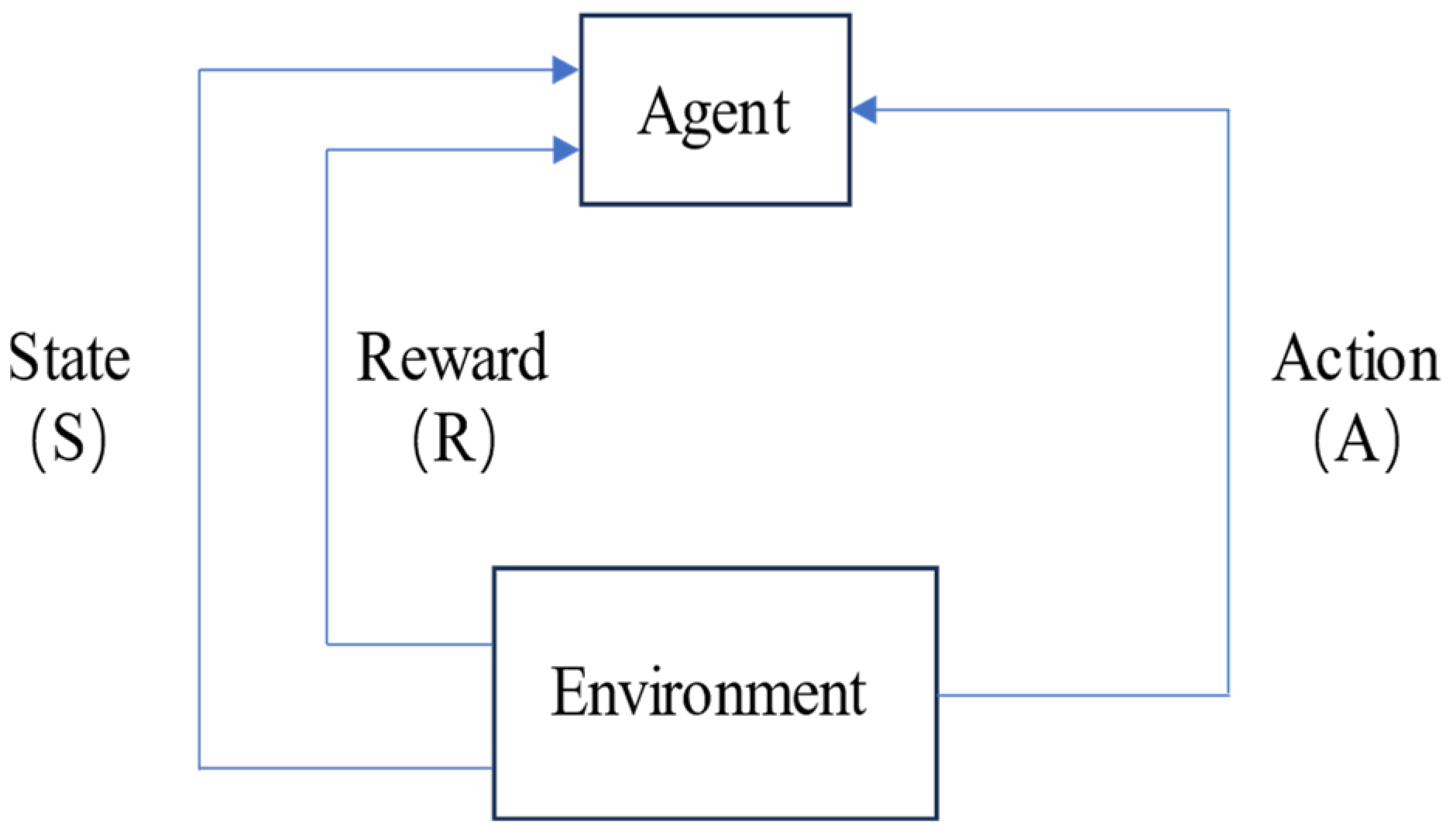
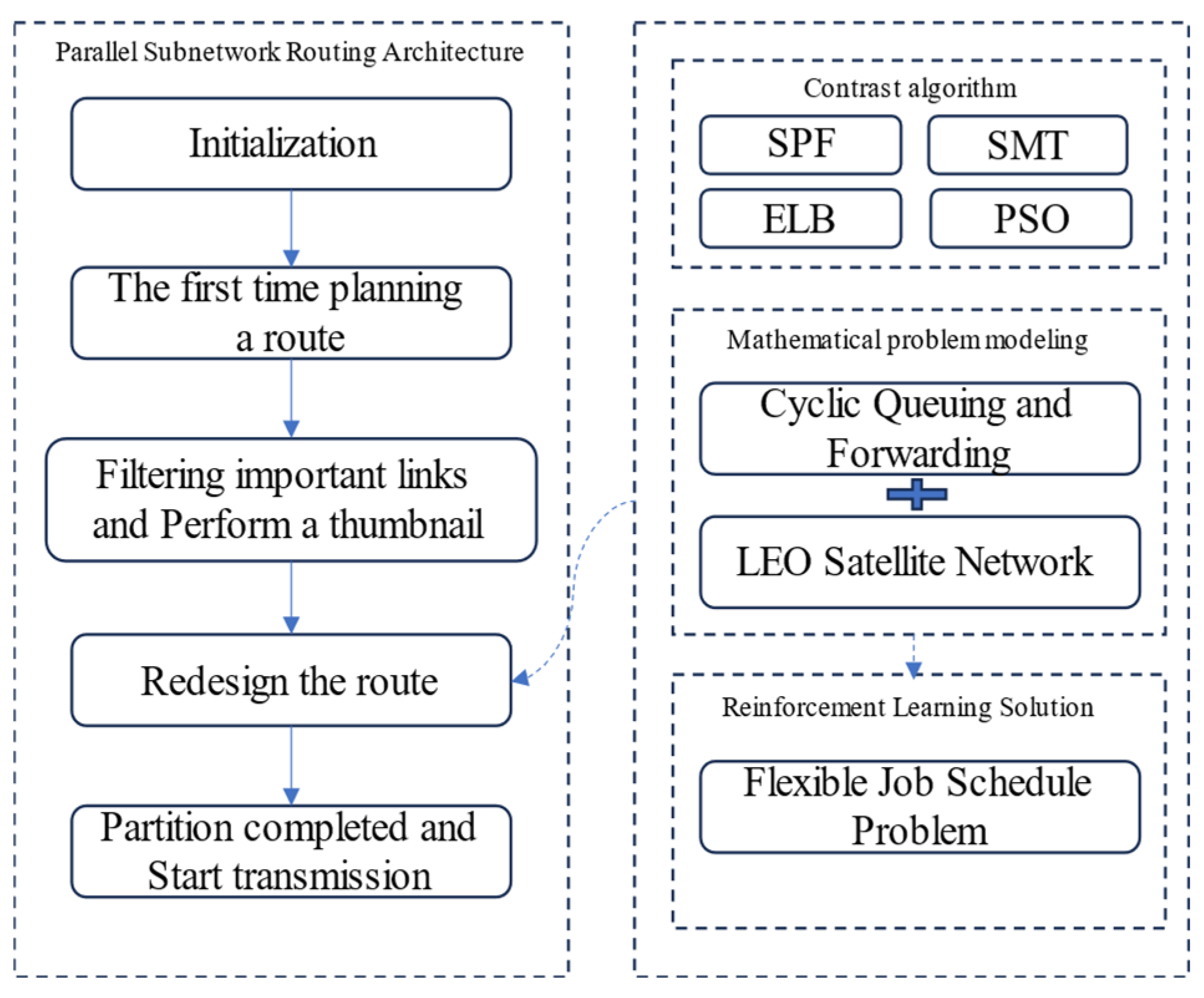
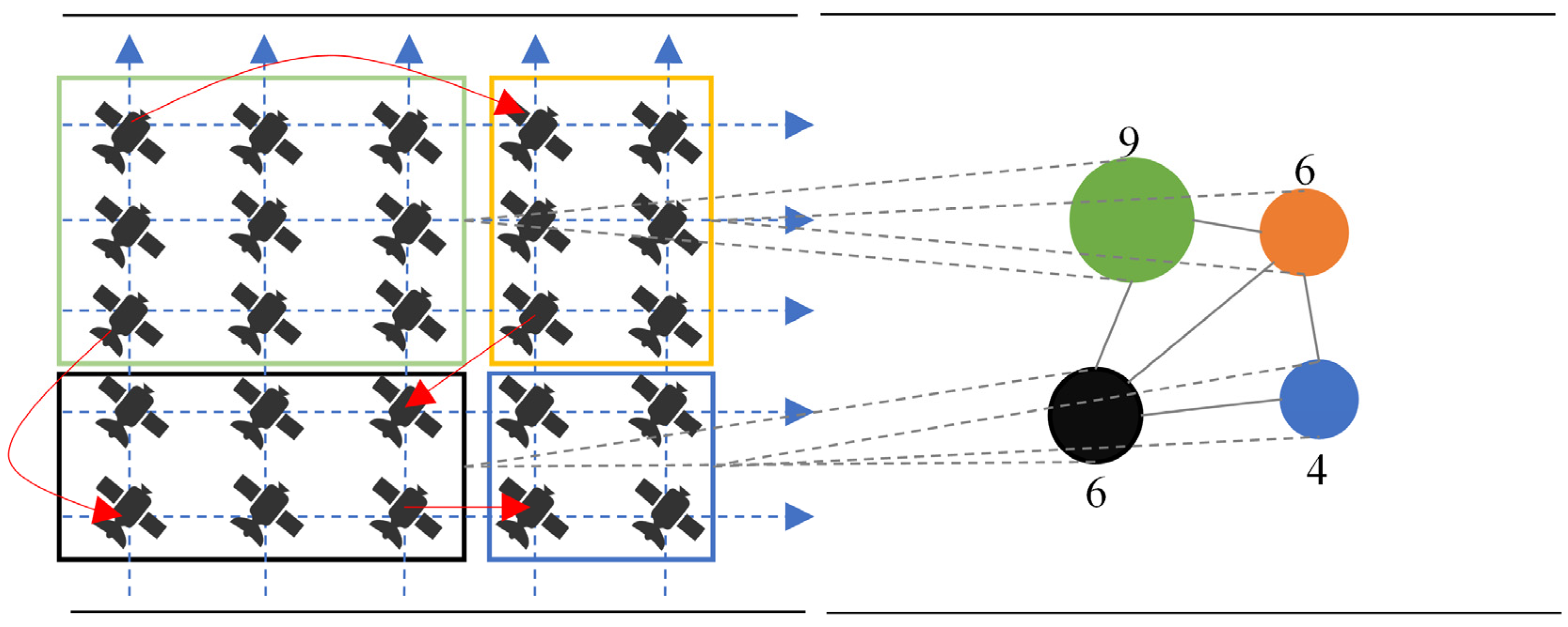

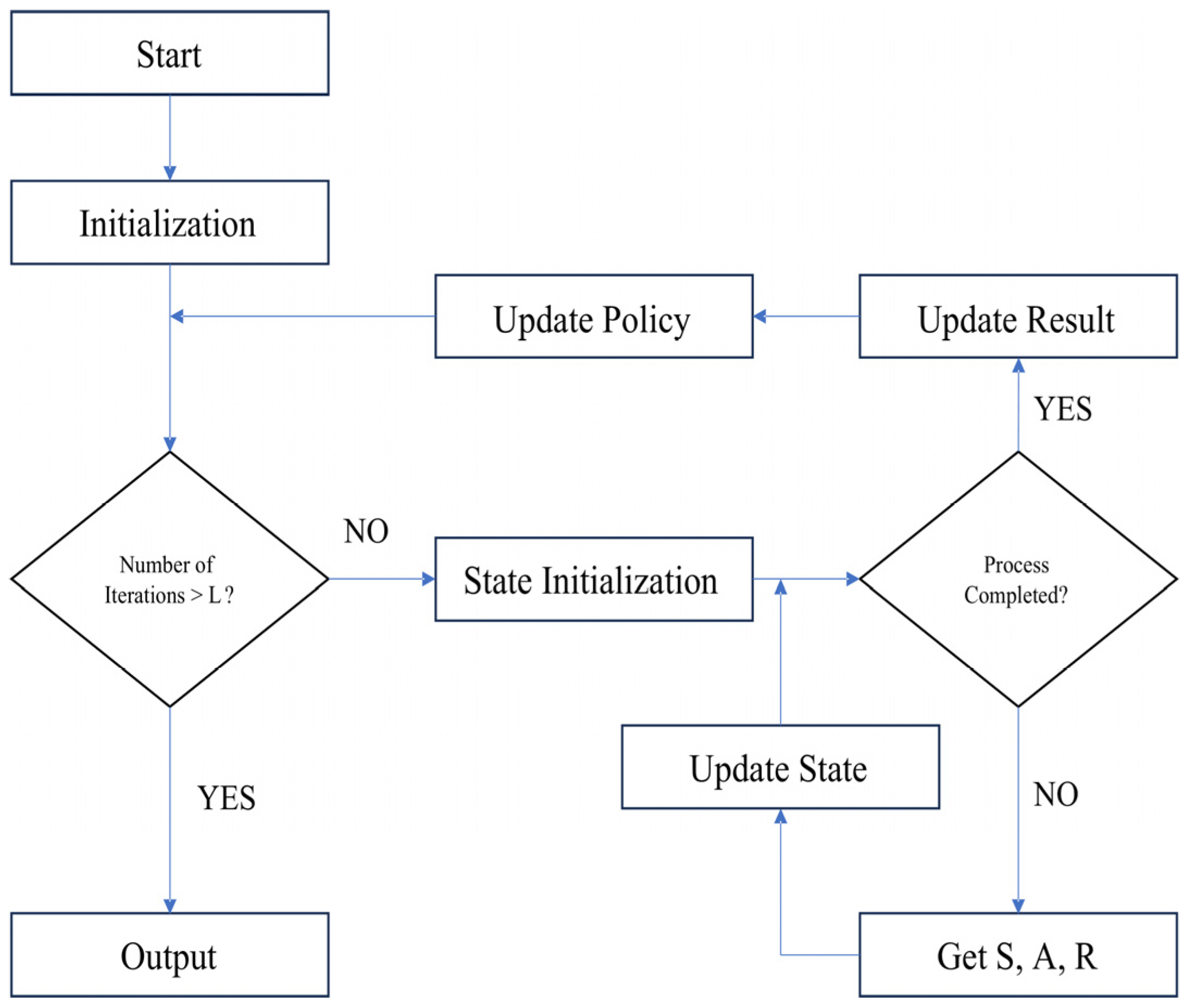

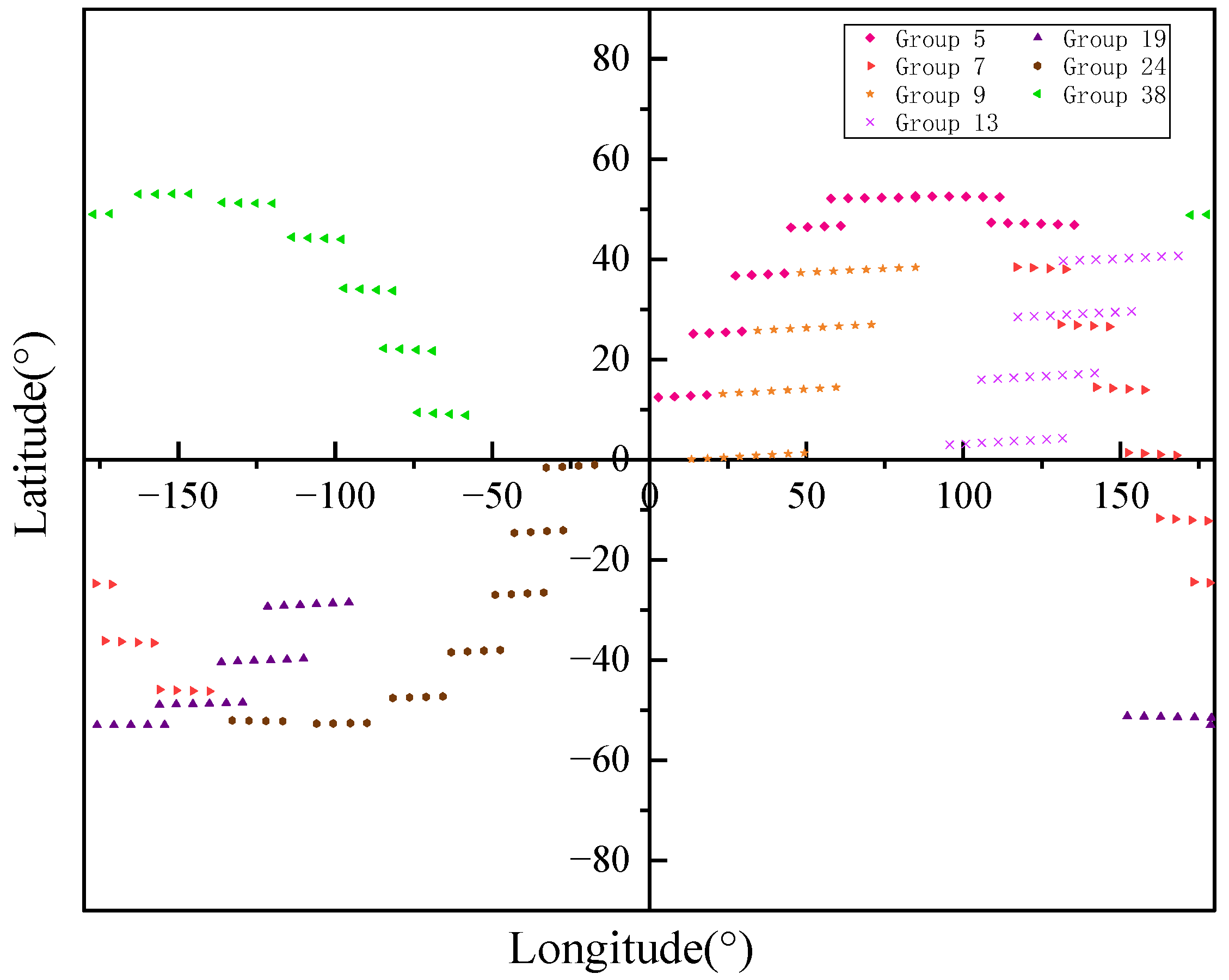
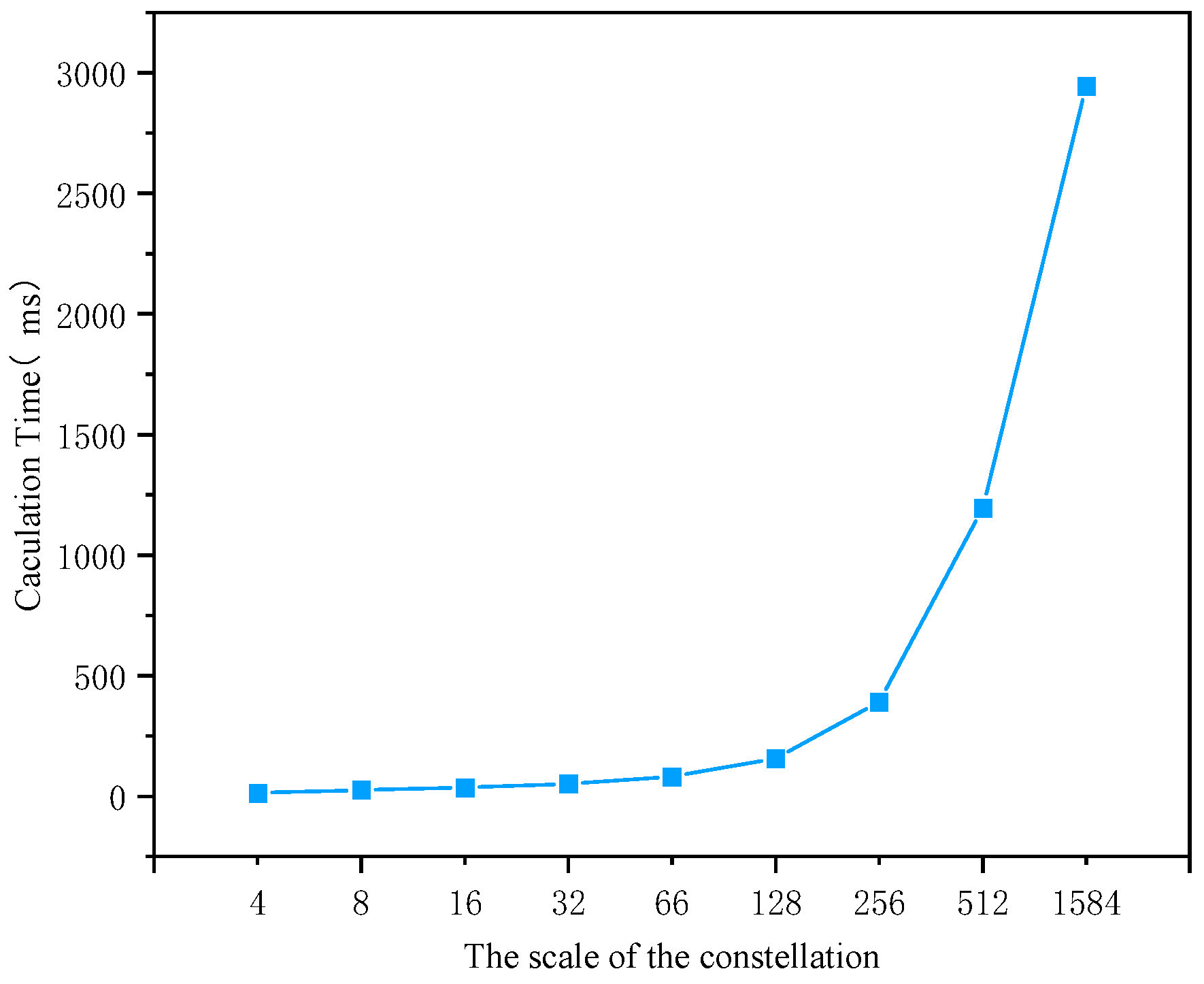
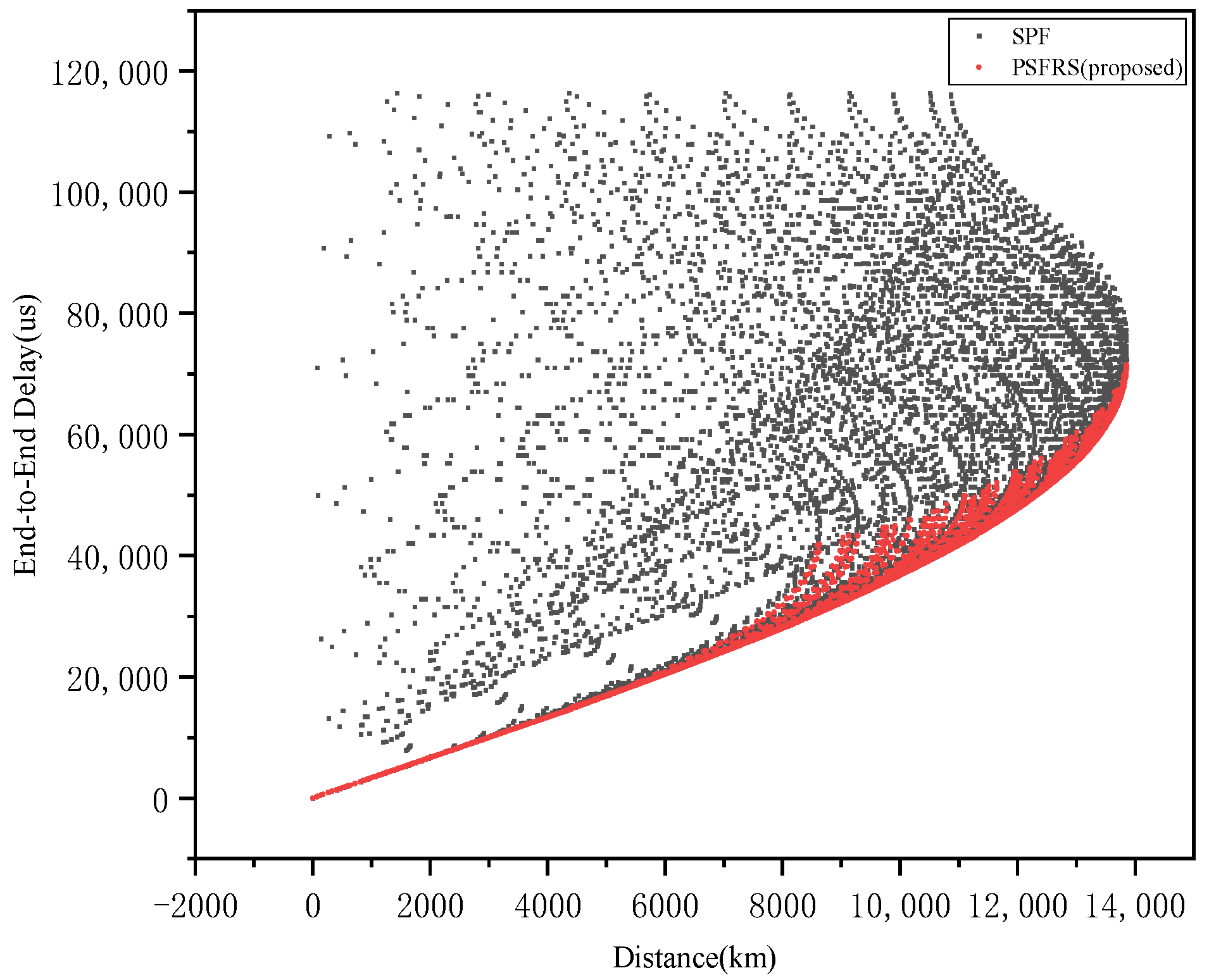


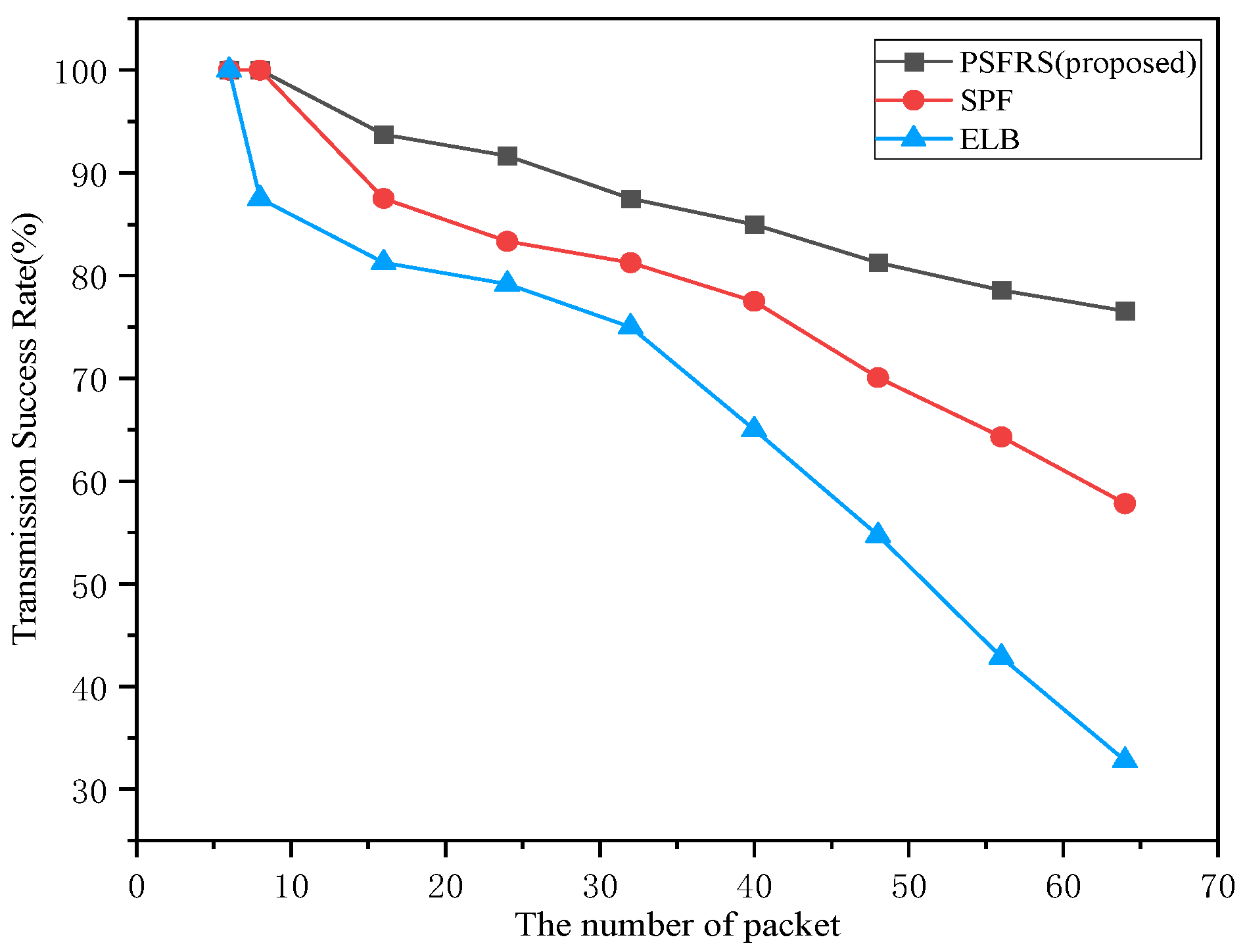
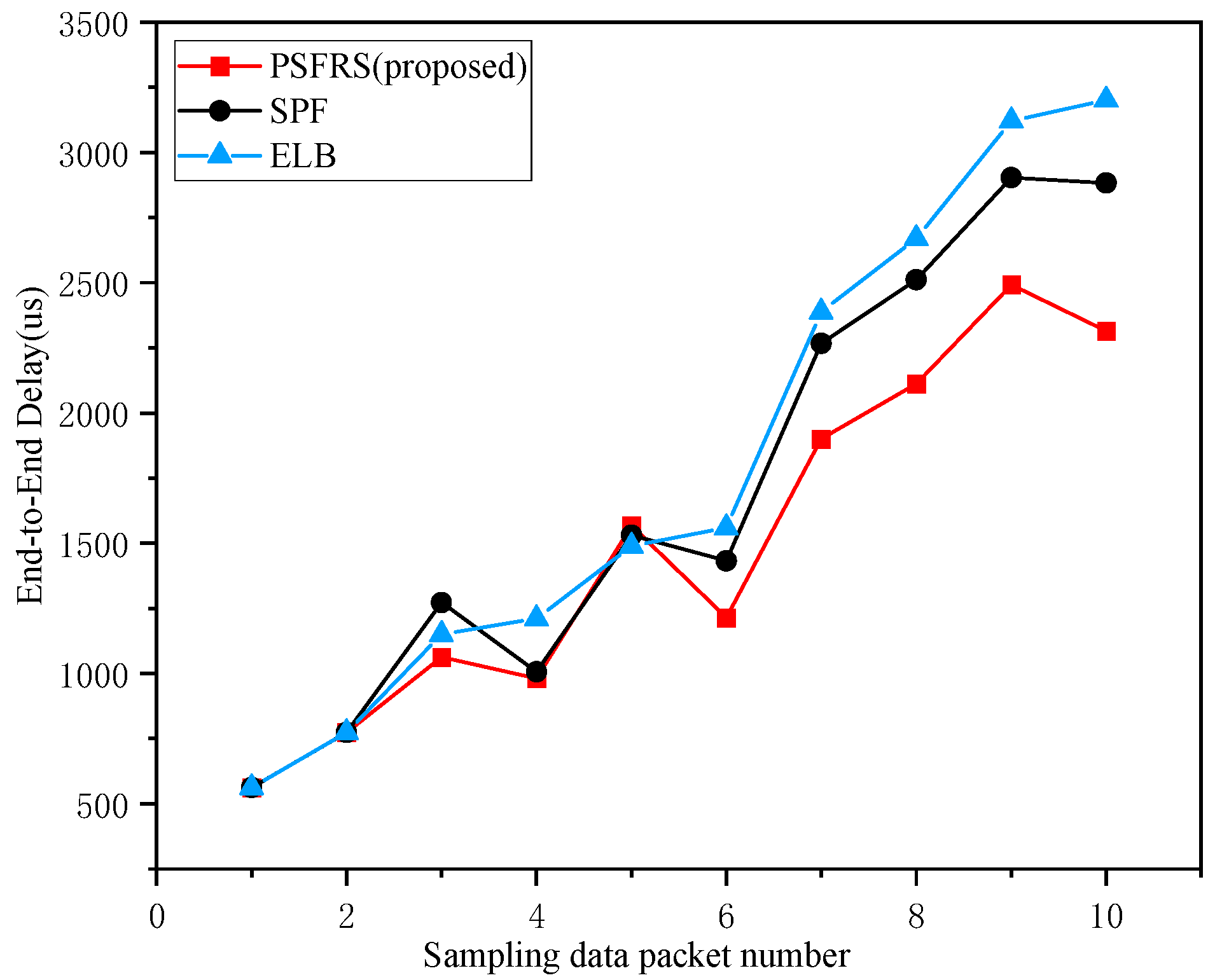
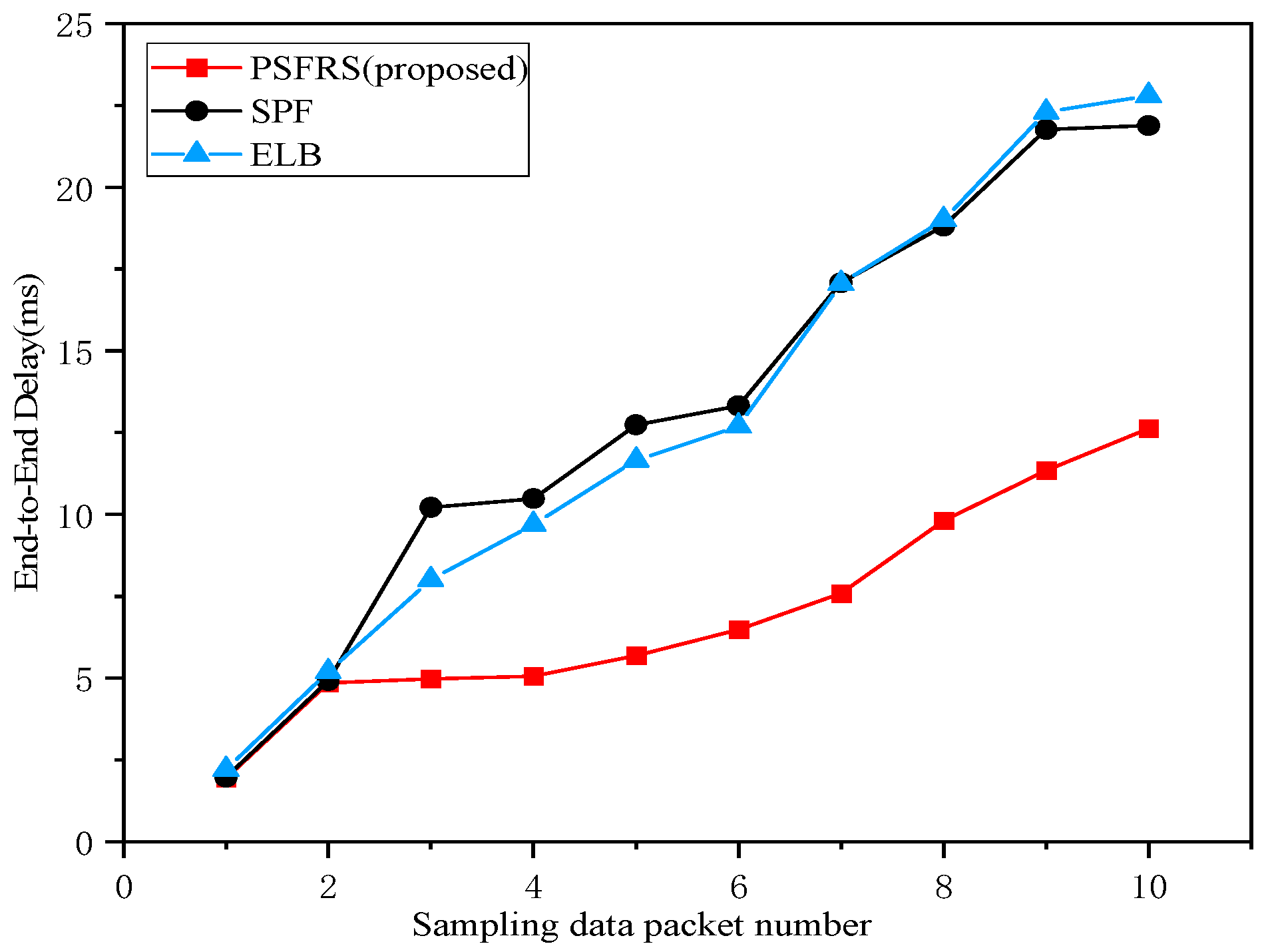
| Classification | Orbital Altitude | Role |
|---|---|---|
| LEO | 500–1500 km | Earth observation satellites, space stations, broadband network services |
| MEO | 1500–35,786 km | Global short message communication, international search and rescue services |
| HEO | Remote location higher than 36,000 km | Strategic and theater surveillance of the Arctic region |
| GEO | 35,786 km | Positioning, navigation, timing services, “bent-pipe” communication, meteorological observation, and other services |
| Symbol | Definition |
|---|---|
| The total number of data packets | |
| Total number of satellites | |
| Satellite serial number | |
| Packet serial number | |
| The total number of hops of the data packet | |
| Hop count sequence number | |
| Forwarding time of the hop of the data packet on satellite | |
| The hop of the data packet | |
| Start time of the hop forwarding of the data packet | |
| Completion time of the hop forwarding of the data packet | |
| Number of optional satellites for the hop of the data packet | |
| A positive number large enough | |
| Transmission completion time | |
| Total task burden |
Disclaimer/Publisher’s Note: The statements, opinions and data contained in all publications are solely those of the individual author(s) and contributor(s) and not of MDPI and/or the editor(s). MDPI and/or the editor(s) disclaim responsibility for any injury to people or property resulting from any ideas, methods, instructions or products referred to in the content. |
© 2025 by the authors. Licensee MDPI, Basel, Switzerland. This article is an open access article distributed under the terms and conditions of the Creative Commons Attribution (CC BY) license (https://creativecommons.org/licenses/by/4.0/).
Share and Cite
Cao, B.; Fan, X.; Hong, Y.; Zhao, Q. Research on Time-Sensitive Service Transmission Routing and Scheduling Strategies Based on Optical Interconnect Low Earth Orbit Mega-Constellations. Appl. Sci. 2025, 15, 3843. https://doi.org/10.3390/app15073843
Cao B, Fan X, Hong Y, Zhao Q. Research on Time-Sensitive Service Transmission Routing and Scheduling Strategies Based on Optical Interconnect Low Earth Orbit Mega-Constellations. Applied Sciences. 2025; 15(7):3843. https://doi.org/10.3390/app15073843
Chicago/Turabian StyleCao, Bingyao, Xiwen Fan, Yiming Hong, and Qianqian Zhao. 2025. "Research on Time-Sensitive Service Transmission Routing and Scheduling Strategies Based on Optical Interconnect Low Earth Orbit Mega-Constellations" Applied Sciences 15, no. 7: 3843. https://doi.org/10.3390/app15073843
APA StyleCao, B., Fan, X., Hong, Y., & Zhao, Q. (2025). Research on Time-Sensitive Service Transmission Routing and Scheduling Strategies Based on Optical Interconnect Low Earth Orbit Mega-Constellations. Applied Sciences, 15(7), 3843. https://doi.org/10.3390/app15073843






